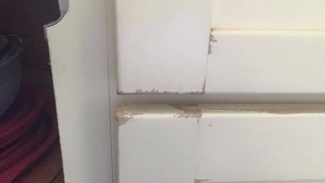


If your current finish is chipping, it is failing to adhere correctly. The adhesion problem could be caused by several reasons:
GF advises extra care and prep when applying any finish over laminate surfaces because they are specifically designed not to mar and therefore they are not very "sand-able", making adherence difficult.
In addition to this non-permeable surface factor, General Finishes Gel Stain is an oil-based product, and it is more difficult to obtain proper drying characteristics over a dense manufactured surface such as laminate. Gel stains, as all wood stains, were formulated to go over raw wood which has an "open" surface and can absorb some of the stain.
Vinyl or paper veneers can be often found on the end returns of lower price-point cabinets. We cannot guarantee that our paints will adhere well to a paper veneer - we have no idea what the actual material is or what adhesives were used to apply the veneer to the surface. The resins and additives in our paints may break down the adhesives used for the veneer.
And Milk Paint does NOT adhere to vinyl.
There is no easy solution to this problem. General Finishes Milk Paint has strong adhesion properties but there are several reasons this finish could fail:
It would depend on whether you plan to use the furniture outside or under the protection of a roof. Theoretically, both water and oil-based products could be used.
For example, you could "antique" wicker with thinned Gel Stain to pop up the color depth on an aging piece of natural wicker. However, Gel Stain is not exterior-rated and is very thick, making it cumbersome to apply and wipe off on a highly textured surface such as wicker.
Brushable White Enamel can be applied to raw wood or existing finishes. When applying over an existing finish, be sure to prep your surface properly.
Learn how to properly prep existing finishes by watching this video.
A primer is your best defense under light-colored paint.
Another technique to avoid the slight color change that sometimes occurs when applying topcoat is to add 10-15% of the paint you are using to your topcoat. This technique layers additional coats of color over your piece as well as providing the protection of a topcoat. If you don't like measuring, just add enough paint until you can see a bit of the hue in the topcoat. This method works with a brush or a spray gun.
To maintain the full-strength protection of the topcoat, DO NOT TINT YOUR FINAL COAT of topcoat.
Tint General Finishes Milk Paint Clear or White base to match colors in major manufacturer's paint decks using Colorfal Zero VOC water soluble colorants.
All bright white paint will yellow slightly with time, even without topcoat. You have probably tried to touch up white woodwork in your home after several years and noticed that the new paint is brighter.
But white and light paints can react if clear coated with a waterbased finish; water-based topcoats are reactive and may draw out substances in the wood such as tannins, dyes or unknown substances in existing finishes causing the topcoat to yellow. This is an industry-wide issue and can happen right away, years later or never.